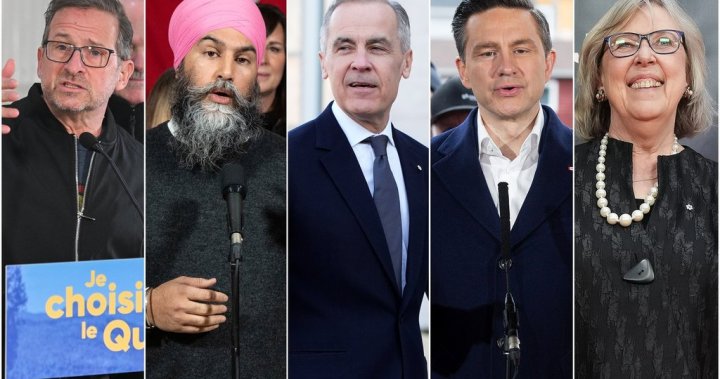Mark Carney’s Liberal Party is currently enjoying a four-point lead over Pierre Poilievre’s Conservatives, right before the general election on Monday, according to new Ipsos data.
However, this close national race hides the Liberals’ clear advantage in Ontario and Québec, which are pivotal for securing a fourth consecutive term from Canadian voters.
The Ipsos poll, conducted for Global News and published on Sunday, shows the Liberals at 42% support nationwide, with the Conservatives at 38%, while Jagmeet Singh’s New Democrats are trailing significantly at only 9%.
Moreover, as the election draws closer, most Canadians seem to have settled on their choices.
“At this late stage, only 5% of Canadians are undecided, and 71% of those who have decided are ‘absolutely certain’ about their choice,” Ipsos stated in a release.
“With votes secured, the focus now shifts to voter turnout and enthusiasm.”
Darrell Bricker, CEO of Ipsos Public Affairs, mentioned on Global News that he anticipates a high voter turnout of approximately 70% of eligible voters and believes the “truly undecided” will likely not participate.
“However, some individuals may not be outright undecided but are leaning towards one party without making a firm commitment until election day,” Bricker explained in an interview.
“In fact, our polling indicates that up to 10% of voters finalize their choice as they enter the voting booth. Therefore, there’s still much at stake, and a four-point lead isn’t insurmountable.”

Get daily National news
Receive the day’s leading news, political, economic, and current affairs headlines in your inbox daily.
The Ipsos survey indicates that Carney’s Liberals are ahead in every region of Canada, except Alberta, Saskatchewan, and Manitoba, which puts the Conservatives in a challenging position.
“The essential factor for a likely Liberal win lies in Canada’s most populated provinces: in Ontario, the Liberals have an eight-point lead over the Conservatives, while in Québec, they enjoy a double-digit margin over all competitors,” Ipsos noted in their statement.
“Additionally, the Liberals have a significant lead in Atlantic Canada and maintain a slight edge in British Columbia, a competitive area, particularly due to the NDP’s decline.”
Poilievre needed to gain traction in Ontario to have a viable chance at forming a government, especially given the numerous seats available in that populous province. According to Ipsos, the Liberals have an eight-point edge there, with 47% support compared to the Conservatives’ 39%.
In Québec, the Liberals hold 40% of the vote, followed by the Bloc Québécois at 25%, the Conservatives at 24%, and the New Democrats trailing at 6%.
British Columbia is predicted to be a three-way contest, showing the Liberals at 42%, the Conservatives at 39%, and the NDP at 13%. The Green Party’s support is just 3%, which could jeopardize party co-leader Elizabeth May’s seat in Saanich-Gulf Islands.
“This is essentially a story of two separate election campaigns,” Bricker explained.
“There’s a clear divide at the Ontario-Manitoba border: west of it and east of it. East of this border, the Liberals have the upper hand across all regions. Unfortunately for the Conservatives, that’s where the majority of election seats are located.”
The support for both parties also appears to be divided by age group. Interestingly, older Canadians are leaning more towards Carney’s Liberals instead of the Conservative Party, which historically does better among those 55 and above.
“A significant advantage for the Liberals is their strong lead among voters aged 55 and older, who typically are more likely to vote. Almost half (48%) in this age group favor the Liberals, while only 34% support the Conservatives,” Ipsos reported.
“Conversely, among those aged 35-54, the Conservatives lead with 43% compared to the Liberals’ 38%. Among younger voters aged 18-34, both parties are tied at 38%, with the NDP slightly growing to 15%.”
Breaking away from recent patterns, Ipsos noted a decrease in the Conservatives’ advantage among male voters, with 42% supporting Poilievre’s party and 40% backing the Liberals. Female voters show 44% support for Carney’s team, while only 35% back the Conservatives.
“Ultimately, voter turnout will dictate the makeup of parliament. The extent of the Liberal victory will hinge on how motivated each party’s supporters are to vote and how effectively they can turn that motivation into actual votes,” Ipsos noted.
Ipsos conducted a survey among 2,500 eligible voters for Global News from April 22 to April 26, using a mix of online and live telephone interviews. The national results are accurate within plus or minus 2.4 percentage points, 19 times out of 20, though the margin of error is wider in provincial and regional results.
© 2025 Global News, a division of Corus Entertainment Inc.




